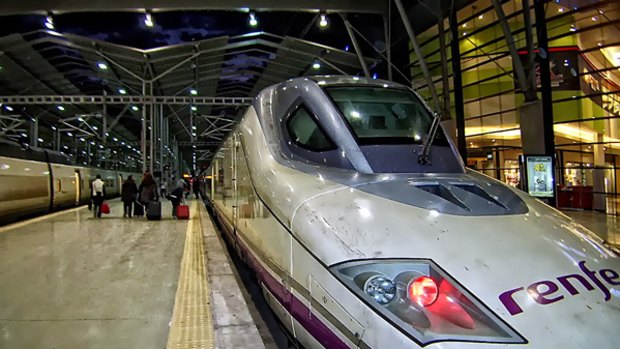
In a blink ... 330kmh AVE trains are booming in popularity.
I can admit to a touch of schadenfreude as I eased back in my chair, trying to contain my laughter. In a swanky bar in the upscale Spanish resort town of Marbella, a friend was recounting his wife's recent divorce threat.
He had chosen to drive from Madrid to the Costa del Sol, while I had opted for the new Alta Velocidad Espanola (AVE) high-speed Spanish train. With a scarred memory of tortoise-like Australian trains, he'd opted for the hare option of a rental car. Sadly for him, the tortoise has overtaken the hare in Spain, with a whole batch of 330kmh trains on new lines opening in the past few years, replacing the slow, shuddering rolling stock of yesteryear.
Spain is taking its high-speed trains very seriously, with an ambitious plan to overtake France in high-speed track by next year and to build an AVE station near to where nine in 10 Spaniards live by 2020. Lines into France and Portugal are also on the cards.
Iberia, the national airline, has almost pulled out of the Madrid to Barcelona route since the AVE arrived last year, with its ability to complete the 630-kilometre journey in 2 1/2 hours.
Speed aside, there are other things going for the train. My friend had romantic ideas of navigating the fabled land of windmills that Cervantes so famously made of La Mancha in Don Quixote. Instead, he found himself, accompanied by an ever-less understanding wife, driving through landscapes resembling the Western Plains of NSW.
Brown mountains give way every so often to vivid diagonal patches of verdant agriculture marking out a valley or other water source. Utes drive back and forth shuttling farmers between the olive groves and Rioja wineries, their drivers immune from the sun beating down on them.
This is gripping stuff for the first 20 minutes in my air-conditioned train, zipping along silently through the countryside, and an idle distraction from the newspapers for a further hour. In the car, however, it was a different tale. Tedium set in less than 50 kilometres from Madrid, my friend reported, and Spanish commercial radio reception was lost at the 100-kilometre mark. The driver tuned to AM radio; his wife tuned out.
Not that I needed much distraction; a full meal is free in first class. In truth, I have had better Spanish meals and much better Spanish wine but there is still something eminently civilised about having proper crockery to eat from and proper cutlery, rather than the airline-issue plastic.
Favourable comparisons with air travel are easy to make: Madrid's Atocha station is in the CBD and, although not as modern as the city's new airport, is a fascinating place to while away the hours, especially since its grand building has been converted into a tropical greenhouse.
Sadly, the station was the site of Europe's worst terrorist atrocity when an al-Qaeda splinter group killed 191 people in March 2004 using a series of bomb attacks on commuter trains. The memorial is a stark, modernist, glass tubular sculpture connecting the train station with the city life above, as the bomb attacks did.
A consequence is airport-style X-ray scanners are required before boarding, unlike much of the rest of Europe's high-speed network. But security is a small price to pay for a system so punctual that delays of more than five minutes result in an automatic full refund.
It was a good 90 minutes into the journey before the landscape changed in any meaningful way. The red, arid plains of the interior started giving way to the craggy mountains of Andalusia. As the city of Cordova looms into view, I get a glimpse of the Islamic architecture from the Caliphate period of Arab rule over Spain in the middle of the last millennium. The architecturally impressive train station is hidden from most of the old quarter of the city, which is the largest UNESCO-protected World Heritage urban site.
From here, the train continues its rapid descent into the Costa del Sol, a coastline synonymous to many British ears with Gold Coast-style hellraising holidays and cheap resorts. In truth, while there are pockets of the Costa in which high-rise condominiums dominate, much of it remains authentic Andalusian. The director of tourism for the Costa del Sol, Salvador Pendon, says Australians are mainly drawn in by the coast's abundance of well-manicured golf courses and famous whitewashed villages in the mountains.
Our terminus is in the port city of Malaga and to reach the impressive Maria Zambrano station (the philosopher was chosen ahead of Antonio Banderas as Malaga's most famous citizen) we squeeze between the city's two rivers.
Ave means bird in Spanish and as our own AVE swooped down gently on our terminus, we arrived relaxed and refreshed. It took quite a few drinks to make my mate feel the same way about his journey. Threatened with a solo journey on the return, he dropped the rental car off in Malaga and booked a ticket on the AVE for the return to Madrid.
TRIP NOTES
Air France has daily connections to Madrid with its daily Qantas code-share from Sydney, with prices starting from $2890. Qantas and British Airways combinations via London start from $1582.
Reservations for the Spanish AVE train are compulsory and can be made 60 days prior to the train departure date. Eurail passes can be used upon payment of an additional seat reservation fee. A three-day Eurail pass for Spain is available from $336 from Rail Plus. See railplus.com.au or phone 1300 555 003. The Spanish rail network Renfe runs 16 services from Madrid to Malaga, one an hour from 6.35am.
See renfe.es/horarios/english/index.html.
Sign up for the Traveller Deals newsletter
Get exclusive travel deals delivered straight to your inbox. Sign up now.